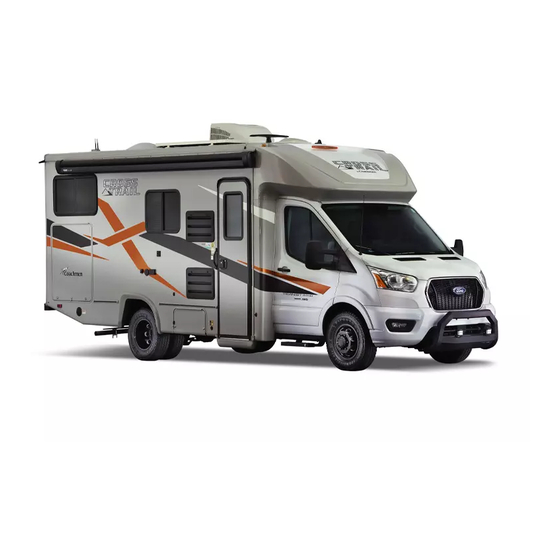
Advertisement
Coachmen Cross Trail User Guide
The Coachmen Cross Trail Ford Transit is equipped with Renogy REGO System which includes the
12.8V/400AH Lithium battery (2
alternator, 3000W Inverter Charger, and a 190W solar panel. The instructions will lay out the
components and how to operate and maintain them.
Must Read Before Operating
•
These instructions are for reference only, please refer to the individual product manuals for
detailed instructions and data.
•
Do not modify or alter the components in any way
•
If issues exist, please refer to the individual product instruction manuals for more detail.
•
For technical assistance please call DEHCO Inc, 1-800-621-2278
•
For more information, please visit
Operating Environment
The Renogy Lithium-Ion battery is designed for the following temperatures:
•
Charge Temperature Range = -4°F to 122°F or -20°C to 50°C
•
Discharge Temperature Range = -4°F to 140°F or -20°C to 60°C
•
Storage Temperature Range = -4°F to 113°F or -20°C to 45°C
•
Operation Relative Humidity = 5% to 95%
battery optional), 12V/60A DC-DC Bi-Directional battery charger from
nd
https://www.renogy.com
V1 11-11-22
Advertisement
Table of Contents

Subscribe to Our Youtube Channel
Summary of Contents for Coachmen RV Cross Trail
- Page 1 Coachmen Cross Trail User Guide V1 11-11-22 The Coachmen Cross Trail Ford Transit is equipped with Renogy REGO System which includes the 12.8V/400AH Lithium battery (2 battery optional), 12V/60A DC-DC Bi-Directional battery charger from alternator, 3000W Inverter Charger, and a 190W solar panel. The instructions will lay out the components and how to operate and maintain them.
- Page 2 Turning Battery ON Turning Battery OFF For Long Storage Go to www.renogy.com to view battery manual for full list of warning/protection parameters as well as Troubleshooting tips.
-
Page 3: Basic Usage
Basic Usage The monitor will display the following items: Renogy One All-in-One Monitoring Display If you want to see more information about an individual component, press on the component on the “Home” screen or press “Devices” and select the component you want to view. With a 2 battery setup the Renogy One will show both batteries when you select the “Battery”... - Page 4 The Renogy One monitor is wired with communication cables to the Battery(s), Charge Controller, and DC-DC Bi-Directional Charger. They will automatically show up on the Renogy One when 12V disconnect is on. Pictures below show communication cables on each component. The Inverter Charger is displayed on Renogy One via Bluetooth.
-
Page 5: Getting Started
Getting Started Turn battery on Turn on battery disconnect switch Turn on inverter charger Make sure breakers are on and enjoy the power from the REGO system 3 ways to charge – Shore Power, Alternator, and Solar Recovery Process If batteries are discharged to 10V or higher depending on the load, then the BMS (battery management system) in the battery will shut down battery to prevent it from being over discharged. -
Page 6: Electrical Connections
Electrical Connections The unit is equipped with a 30A 120VAC “shore power” connection. The 30A connection is always best, however, if a connection of less than 120VAC 30A is going to be used, the inverter/charger charge rate may need to be reduced, refer to “Shore Settings” below. Shore Settings The only adjustment needed to the inverter is to change the AC Charging Current. -
Page 7: Component Locations
COMPONENT LOCATIONS 1) RIV1230RCL-1SS 3) RCC60REGO 12V/3000W Inverter Charger 12V/60A MPPT Charge Controller • 75A AC Charge • 60A Rated Solar Charge Current • On/Off Remote Switch • 800W Max Solar PV Input • Lithium Battery Activation • 100V Max PV Input Voltage •... - Page 8 5) RMS-LP4 All-in-One Energy Monitoring • Monitors Battery, Solar, Inverter and DC-DC charger • Support multiple communication methods, Bluetooth, WiFi, LoRa, Zigbee, Modbus, RV-C • Can be linked to mobile device through Renogy DC Home App 6) RIV1230RCL-1SS INVERTER ON/OFF BUTTON Inverter Charger ON/OFF Remote Switch •...
-
Page 9: Common Issues
Inverter Faults Common Issues There are several issues that can cause fault, the most common are: 1. Battery Low Voltage Warning (04) when battery needs to be charged 2. Inverter Overload (07) when loads exceed the 3000W rated output power 3. - Page 10 Battery 101 How to quickly calculate power for consumption, and recharge. There is a physical limit to the amount of stored power, so power must be budgeted. You can determine what each activity, or load will “cost you” in watt-hours. This will help you understand power usage, and how to make your reserve last when shore power is not available.

Need help?
Do you have a question about the Cross Trail and is the answer not in the manual?
Questions and answers